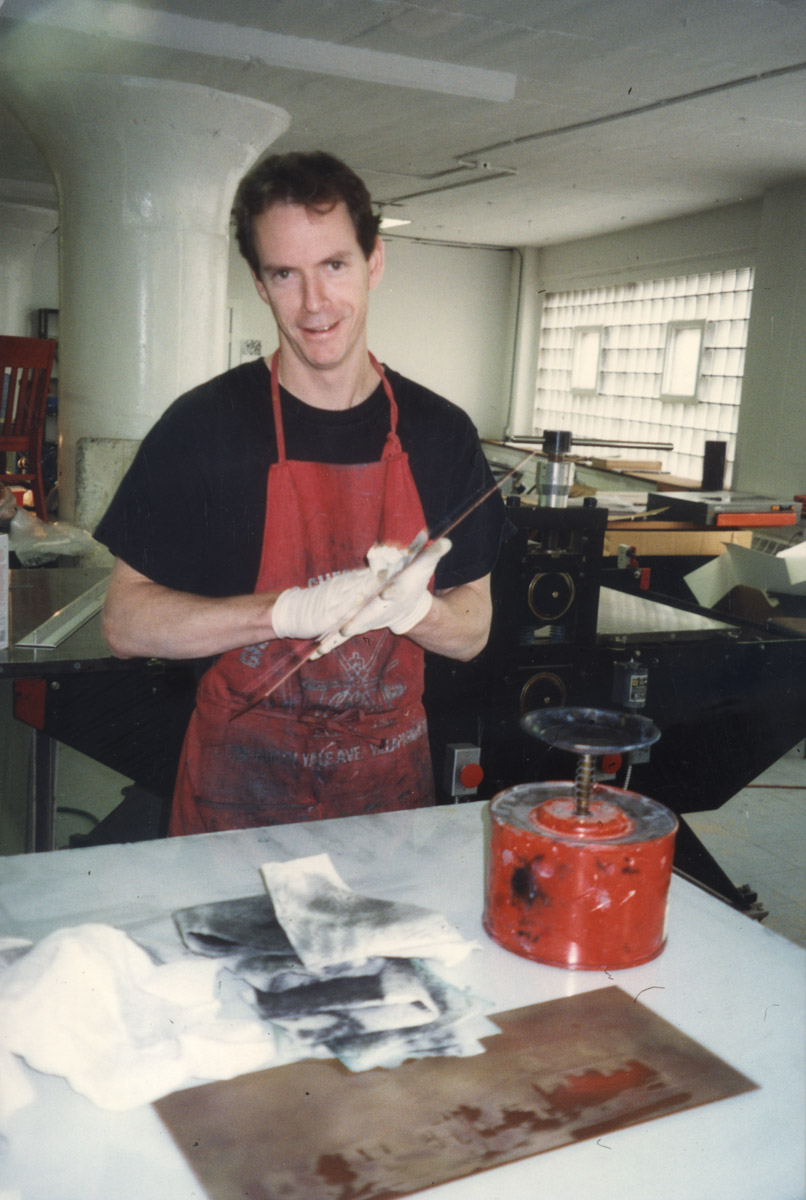
Charles Ritchie, trial proof for Accordion Print, 2008, etching on wove paper, sheet size: 13 x 10 1/4″. A trial proof is a test printing that reveals the artist’s work on a printing plate.
Part 2: Trial proof created from drawings on Mylar transfered to a printing plate
I have just received a first proof that shows the results from the test I started a few weeks ago (see online journal entry, A New Print Project Part 1) Printer Jim Stroud transferred the pen and ink writing/drawing I did on Mylar to a printing plate. The clear Mylar was placed face down on photo sensitized plates and a bright light exposed the plates. The areas not blocked by my writing/drawing were changed, hardened so that acid cannot eat away at them. The other areas remained open and when the plates were placed in a bath of acid the open areas allowed acid to eat into the copper printing plate. When the plates are removed from the acid and cleaned, these recessions are the areas that hold printing ink.
Two plates were prepared, one showed the drawing and the other the writing. Jim inked these plates and juxtaposed them on the press bed. He placed a sheet of dampened paper over the plates and ran them through the printing press (see image above). The writing transferred very well with very precise detail in the script. Jim used a graphite ink to print; a dark silvery-gray, echoing the pencil writing that often accompanies many of my drawings. While we will probably want to incorporate some of this graphite ink, most of my inscriptions will probably be in black, in the fashion of most of my notebook/journals, thus in the next proof we will probably want to use a black ink. Another more challenging obstacle is that there are very fine scratches all through the handwritten areas. These are slight abrasions that probably occurred while I was writing on the Mylar. If I am to continue working in this direction, I will have to be particularly careful not to allow scratching on the clear Mylar surface.
The transfer of the drawing went well, fairly detailed; however I probably went too far with the crosshatching. The black lines really filled in too much, effacing more detail than I would have liked. However, I am not really concerned with this as I will probably want to only create outlines of drawings for photographic transfer to the plate. I really prefer to work directly into the plate in etching and drypoint. The lines will be crisper and fresher and retain the nuances of hand-working than if they were photographically translated.
After seeing this trial proof I will set the Mylar transfer idea aside and try another approach. I will write and draw on a long sheet of Arches 90 pound hot press paper (which is my preferred drawing paper for my handmade journals). On this paper I will inscribe my texts and draw the outlines of my images in order to arrange the compositions of my pages. When complete I will send these drawings on paper to Jim who will have them photographically transfered to printing plates. I will then draw in etching, drypoint, and possibly mezzotint directly on the plates (to be continued).

Photograph of Printer James Stroud removing ink from copper printing plates, Center Street Studio, in the workshop’s previous location, Boston, April 1996.